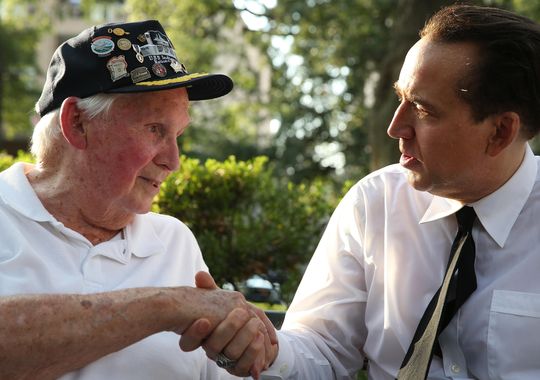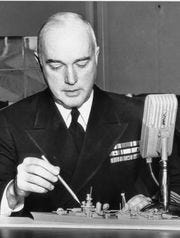QUAND HOLLYWOOD RACONTE L’HISTOIRE POIGNANTE DE L’USS INDIANAPOLIS AVEC NICOLAS CAGE

INDIANAPOLIS — The story of the USS Indianapolis has been often told.
Yet despite the violence and horror of what is considered the worst disaster in U.S. naval history, the story is still not widely known.
At least seven books have been written, but books about World War II history don’t usually attract wide attention. In 1991 a movie was done, but it was a made-for-TV effort starring Stacy Keach.
Suddenly though, as the 70th anniversary of the July 30 sinking approaches, two major motion pictures are in the works. USS Indianapolis: Men of Courage, starring Oscar-winner Nicolas Cage, began filming last month. Another project, still in development, would involve Robert Downey Jr., either on screen or in a producer role.
For the Indianapolis’ crewmen, who are in their 80s and 90s, the widespread recognition that a major motion picture can bring has been a long time coming. Although many of them were haunted by their ordeal, “they want their story to be remembered,” said Maria Bullard, the daughter of survivor Harold Eck and the chairman of Second Watch, a club for the crewmen’s families.
“I have a whole box of documentaries,” Bullard said, “but a Hollywood movie is the best way to get this story across to a worldwide audience. We all just feel like it’s time for this to be told on the big screen.”
The sinking of the USS Indianapolis occurred the night of July 30, 1945. The ship was returning from a U.S. base on Tinian Island in the Philippine Sea, where it had delivered enriched uranium and other components for an atomic bomb. That bomb would later be dropped on the Japanese city of Hiroshima.
A Japanese submarine slammed two torpedoes into the Indianapolis. The ship sank inside 15 minutes. The 900-some crewmen not killed in the initial attack went into the water, poorly equipped, some without so much as a life jacket.

he men huddled in small groups and wrestled with dehydration, hunger, hallucinations and sharks.
“There soon were hundreds of fins around us,” wrote Eck in the 2002 book Only 317 Survived, a compilation of survivors’ stories. “The first attack I saw was on a sailor who had drifted away from the group. I heard yelling and screaming and saw him thrashing … then I just saw red foamy water.
“My legs dangled in the water and were constantly being bumped by the sharks swimming below. I curled my legs up under me as close as I could.”
Crewmen died for lack of water, too, and of exposure. Survivors would remove the life jackets from crewmen who died in the water and set them adrift. Sharks would come, Eck wrote, “and the floating dead were taken in a feeding frenzy.”
A rescue came on Day 5. Nearly 600 men had perished in the sea.

Such drama would seem to be the stuff of box office gold.
But unlike Unbroken, the World War II true story that was made into a movie last year and posted $30 million in ticket sales its first weekend, the USS Indianapolis story did not end happily. Most of the crewmen died. Their commander, Capt. Charles B. McVay, was court-martialed and driven to suicide. The ship’s mission, though it did speed the war to its conclusion, led to death and destruction of a scope never before seen in human history.
“The overall picture is depressing,” said Tim Irwin, artistic director of the nonprofit arts organization Heartland Film, “so you’d have to focus on an individual. Often they make it an amalgamation. I’m guessing they’ll find a more positive side.”
Filmmakers typically do. With Titanic, the 1997 film starring Leonardo DiCaprio and Kate Winslet, director James Cameron turned the story of the doomed ocean liner into not just a special-effects maritime disaster but a testament to everlasting love. It ranks among the biggest grossing films of all time. Michael Bay’s Pearl Harbor, the 2001 film starring Ben Affleck, Josh Hartnett and Kate Beckinsale, is about the deadly surprise attack but also about human bonding.
At least seven movies have been made about Pearl Harbor, and 22 about the Titanic.
